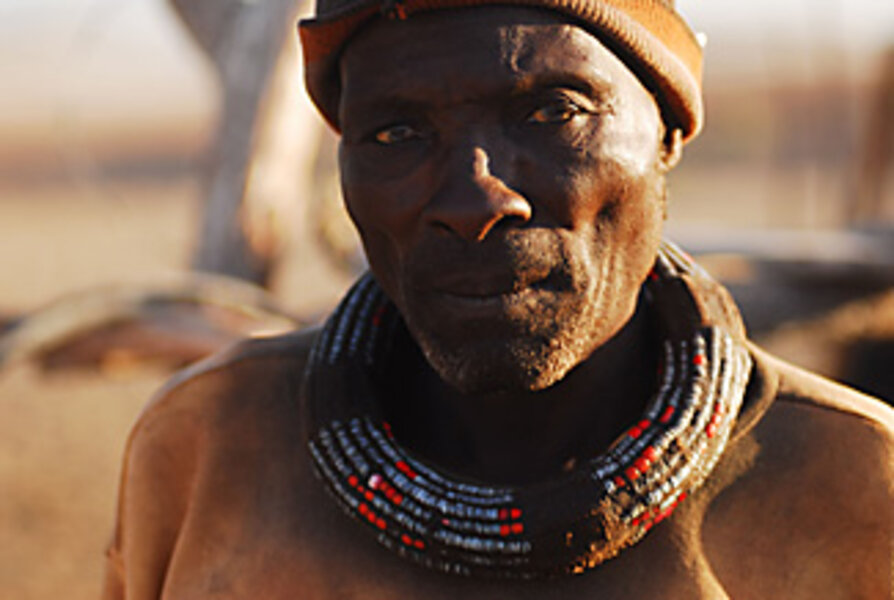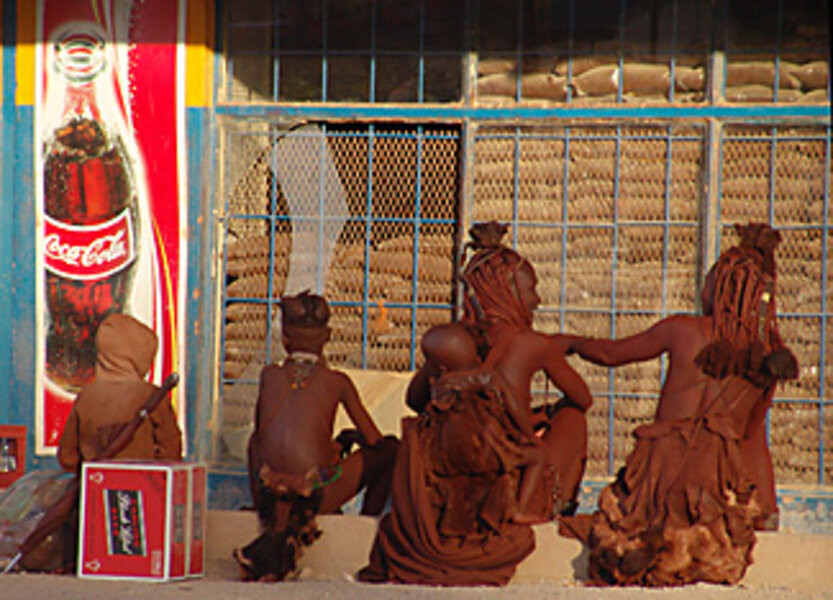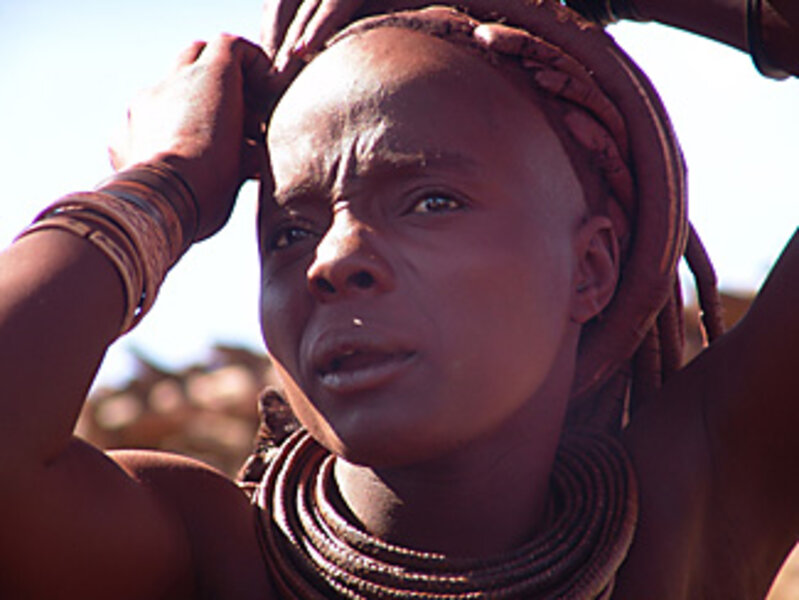Urbanization threatens Namibia's traditional Himba culture
Loading...
| Opuwo, Namibia
As the sun drops behind the dusty main street here, the crowd at the informal market behind the OK Grocer gets bigger. Twenty-somethings in Western clothes slap hands in greeting, older men sit in the red dust drinking home-brewed beer out of plastic buckets, women haggle with stall merchants for the last best price on tomatoes and T-shirts.
Scattered throughout the scene are Himbas – members of one of Southern Africa's last traditionally living pastoral tribes. Two Himba women – bare breasted and wearing animal-skin skirts, their bodies covered in an auburn mixture of ochre and animal fat – lean in the doorway of a bar and pool hall. A Himba man, twiglike spear tucked behind his ear, laughs at a joke made by two men in jeans. A group of older Himba women stand in a circle, clapping frenetic rhythms as they take turns dancing in the center, shaking their heads and hips while the others laugh gleefully, some drunkenly.
Ten years ago, it would have been unusual to see Himba here, residents say. But Opuwo is changing, as are the cultures that have long flourished around it. Opuwo now finds itself on the ever-shifting border where traditional culture and modern Africa meet.
"We are many Himba here in town," says Mackey Natundu, who wears slacks and a button-down shirt, but identifies himself as Himba. He says his family is in a village in the mountains, but because he hopes to find a job he stays in Opuwo, the closest thing to an urban center in arid, remote northern Namibia. "People come here and they don't like to go back."
Another man in Western garb approaches.
"You want to take pictures of the Himba?" he asks, moving close. "You must give something." He makes a sign for money and grabs a visitor's arm. "Come, we take pictures of the Himba."
Mr. Natundu shoos him away. The sun – heavy and orange – drops lower on the Namibian horizon, and the market seems to get louder.
"The real traditions are in the village," Natundu says with a sigh. "People, they come here and drink."
For years, Opuwo has been a frontier town – the last stop before the vast, dry north beyond; the only place with a supermarket and gas station until the Angolan border 100 miles away. Under apartheid South African rule, when Namibia was called South West Africa, this was the only administrative post in the north. The town's name means "the end" in the language of the Herero, another ethnic group, which is also spoken by the Himba.
Today, Opuwo is growing – in part because of an expanded civil service, in part because of the urbanization sweeping across Africa. And it is increasingly attracting young Himba.
"Opuwo has been the gateway to the world beyond it," says David P. Crandall, an anthropologist at Brigham Young University who has studied and written a book on the Himba. "And it is a world that is attractive to the teenage boys.... These men have a leg in the Himba world and have a leg in what they see as a new, hip life in Opuwo."
•••
Flipping through guidebooks for Namibia, it's easy to get an impression that the oft-photographed Himba are a beleaguered group. The Lonely Planet cautions travelers that paying for photos undermines the traditionally cash-free Himba culture; the Footprint guide says the "breathtaking and dramatic" Himba are "under threat" from tourism, traders, and politics.
Most locals and experts agree that the Himba have gone through some tough times recently. Anthropologist and indigenous rights activist Margaret Jacobsohn writes in "Himba: Nomads of Namibia" that in the 1980s – what the Himba call "the time when people had to eat their leather garments" – drought killed 80 to 90 percent of the region's cattle. Around the same time, the bush war between Namibia freedom fighters and apartheid South African security forces trapped many Himba in crossfire that has left distrust between the country's ruling party and the tribe. And government plans to build a dam that would flood much Himba grazing area have alarmed the Himba and their supporters.
But the 15,000 or so Himba are still one of the most successful and wealthy ethnic groups in the country, Ms. Jacobsohn and others point out. And Professr Crandall says he questions the reality of a wide-scale "threat" to Himba culture. "I think it's fundamentally wrong to think of a culture as static," says Crandall, who spent a year living in a Himba village near Opuwo. "The Himba today, or even the Himba of 20 years ago, do not live the same way as they did 100 years ago. There's always some adaptation to local circumstance."
•••
If Opuwo is one side of this adaptation, the village of Ohungumure is another. It's a half-hour drive from Opuwo – first along rolling dirt roads, then on an all but unmarked turnoff through a patch of short mopane trees. Soon, family compounds come into sight – fenced areas, each with a kraal for animals, a holy fire for ancestors, and a hut for each of the patriarch's wives.
In one compound, Kakuindjowe Muharukua introduces herself as the first born. She explains that her father has five wives and says that the dozen or so women working on beaded necklaces and ankle bracelets here are all related. There are no men around – they're out watching the cattle, the lifeblood of the Himba.
"Everything has a meaning," she says, when asked why one woman had her hair tied on top of her head with an animal skin, while a younger girl had thick, mud-coated locks falling in front of her face.
Hairstyles symbolize different life stages, she explains. Boys have ponytails, but when they marry, they pull all of their hair up in a cloth. Young girls have their hair plaited at the back of their head. When girls reach puberty they comb their hair over their faces; after they start menstruating they reveal their faces. Then, when a mother decides her daughter is ready to start having babies, she puts her hair up with a skin.
It is acceptable in Himba culture for women to start having babies before marriage – to get started early, she says. "You should have at least six children," she says. "If you don't have six children, people wonder what is wrong."
Soon, women from other homesteads, dotted about a quarter to half a mile apart, start milling into the Muharukua compound, interested in the visitors. Many bring beadwork to sell.
"We sell to the Herero, and to the [tourist] visitors who come and see us," says a woman named Ovingoringo.
Inside one hut, teenaged Maroroco Muharukua lies a few feet from a fire's embers. Calfskin bowls hanging on the wall above her keep butter cool. She once tried to go to a government satellite school in the mountains near her village, but it upset her mother, who said she should stay at home. Other women at the homestead also talk about school with wariness.
Until the 1980s, according to Jacobsohn, only a handful of Himba children went to school. Today, Crandall says, many Himba see reasons for boys to get some education and learn English, but some are still nervous.
A woman at the homestead who identifies herself by the one name, Tjanakambedje, says her son sneaked away to school and now is a teacher in a different town, only coming back to the villages for ceremonies. Marococo also knows young people who have left.
"I have got one friend, she went to the city and we don't know where she is now," she says.
As for Marococo, she says her goal these days is to remain in what she considers true Himba culture. "I might go to school, but only if they allow me to be in my tradition," she says. "I want to be in my village."







